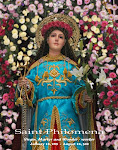Praised be Jesus, Mary, and
Joseph!
“Ito ang aking dugo ng tipan, and
dugong mabubuhos dahil sa marami,” (This is my blood of the covenant which will
be shed for many) says the Lord. The reading for the feast of Corpus et Sanguis
Christi this year gives more emphasis on the Blood of the Lord Jesus which was
shed for the forgiveness of sins. By consecrating the wine into his blood of
the Covenant, the Lord Jesus brings us back to Mount Sinai where Moses offered
a sacrifice of young bulls as peace offerings to the Lord (Sila ay inutusan
niyang pumatay ng mga hayop na gagamiting handog sa pakikipagtipan sa
Panginoon). Moses splashed half of the blood on the altar and when the people
pledged obedience to the covenant, he sprinkled the other half of the blood on
the people as he said, “This is the blood of the covenant that the Lord has
made with you…” This was how the covenant between God and his people was
sealed. If today, parties enter into an agreement by signing a contract, God
and his people entered into an agreement or covenant by the sprinkling of
blood. Blood, being the conduit of a living creature’s life, is sacred. It has
consecratory power. It seals a relationship. It binds persons into a
relationship.
In order for blood to be
obtained, a victim has to die in a sacrifice. In the case of the covenant on
Mount Sinai, the victims were bulls. At the last supper, the victim was Christ.
In any religion, the sacrifice was always deemed as the highest form of
worship. It was so because it was the costliest…it involved the death of a
victim which was slaughtered to proclaim the sovereignty of the deity over life
itself. For the Israelites, animals were suitable victims. For other religions,
humans were offered. But for us, we offer to God his beloved Son Jesus: “Christ
entered once for all into the sanctuary, not with the blood of goats and
calves, but with his own blood, thus obtaining eternal redemption.” (Minsan
lamang pumasok si Kristo sa Dakong Kabanal banalan, at iyo’y sapat na. Hindi
dugo ng mga kambing at bisirong baka ang kanyang dalang handog, kundi ang
sariling dugo, sa ikapagpapatawad ng mga kasalanan natin.) Thus, we should
remember that the Mass is not simply a meal or a banquet. It is a sacrificial
meal wherein the Body and Blood of Jesus is offered to the Father. Thus, the
Mass is the highest form of worship not only for us Catholics, but for the
whole world. We say this because the victim offered at Mass is not just any
animal or human being. The Victim offered is Christ himself. He is the
Salutaris Hostia, the Saving Victim, the one who dies in order to obtain the
forgiveness of our sins: “Sa pamamagitan ng walang hanggang Espiritu ay inialay
niya sa Diyos ang kanyang sarili na walang kapintasan. Ang kanyang dugo ang
lumilinis sa ating puso’t isip upang talikdan na natin ang mga gawang walang
kabuluhan at paglingkuran natin ang Diyos na buhay.”
We should always be aware of what
transpires at the altar during the Mass. What we have in the Eucharist is more
than just a banquet that celebrates unity. What we have here is a real
sacrifice, a real offering of the Lamb who once was slain and now who lives for
ever. “On the Altar of the Cross He offered up His Body to God the Father as a
sacrifice for our reconciliation He shed His Blood as the price whereby He
redeems us from wretchedness and bondage, and the washing whereby He cleanses
us from all sin. And for a noble and abiding memorial of that so great work of
His goodness, He has left unto His faithful ones the Same His very Body for
Meat, and the Same His very Blood for Drink, to be fed upon under the
appearance of bread and wine.” (St. Thomas Aquinas, 57th Opuscula.)
Let us reverently enter into the presence of God. Let us partake of this
sacrifice by keeping in mind that what we eat and drink is the One, who out of
love for us, died on the Cross to atone for our sins.
Jesus, I trust in you. O Mary
conceived without sin, pray for us who have recourse to thee.











No comments:
Post a Comment